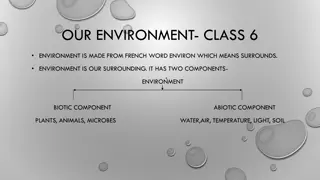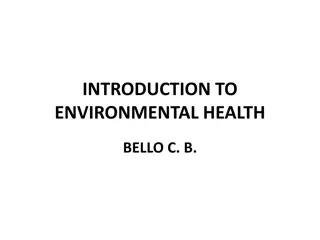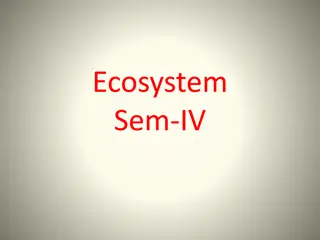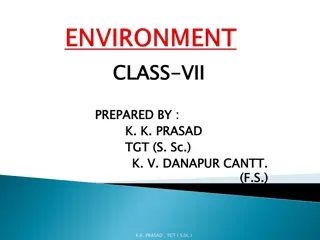Components of Environment and Their Significance
In our surroundings, the environment comprises both living and nonliving entities that play a crucial role in sustaining life on Earth. This article delves into the major components of the environment, including the biological and physical aspects, exploring their interdependence and impact on ecosystems and the planet as a whole.
Download Presentation

Please find below an Image/Link to download the presentation.
The content on the website is provided AS IS for your information and personal use only. It may not be sold, licensed, or shared on other websites without obtaining consent from the author.If you encounter any issues during the download, it is possible that the publisher has removed the file from their server.
You are allowed to download the files provided on this website for personal or commercial use, subject to the condition that they are used lawfully. All files are the property of their respective owners.
The content on the website is provided AS IS for your information and personal use only. It may not be sold, licensed, or shared on other websites without obtaining consent from the author.
E N D
Presentation Transcript
StudyMafia.Org Major Components Of Environment Submitted To: Submitted By: Studymafia.org Studymafia.org
Table Contents Definition Introduction Major Components of Environment Conclusion 2
Definition Everything in our immediate surrounds, including both living and nonliving things like soil, water, creatures, and plants that adapt to their conditions, is referred to as the environment. 3
Introduction It is a gift from nature that helps to sustain life on Earth. The survival of life on Earth depends on the environment. A biosphere component that affects the condition of the entire planet is an ecosystem. It includes both live and inanimate objects in the environment. 4
Major Components of Environment Biological Component The biological component of environment, as the name suggests, consists of all living organisms. As a result, it is frequently referred to as the biotic component of the ecosystem. Animals, plants, and microorganisms interact with abiotic elements to build ecosystems. Additionally, several types of organisms, including producers, consumers, and decomposers, are separated apart in these ecosystems. 6
Major Components of Environment Physical Component The physical component of the environment is the non-living portion. Abiotic factors, which include things like air, water, soil, and climate, are also referred to as them. The three major categories of physical elements are the atmosphere, the hydrosphere, and the lithosphere. Scientists frequently refer to the zone of life as the biosphere (or the worldwide sum of ecosystems). 7
Major Components of Environment Lithosphere: The crust, the earth s topmost layer, is composed of several minerals. It can be found on both land (terrestrial crust) and the oceans, where its depth can reach up to 100 kilometres (oceanic crust). Tectonic plates on Earth are the primary part of the lithosphere. 8
Major Components of Environment Hydrosphere: It includes all types of water bodies found on Earth, such as oceans, seas, rivers, lakes, ponds, and streams, among others. On Earth, it covers 70% of the surface. The oceans contain salt water, which makes up 97.5% of the total amount of water on Earth. Freshwater makes up only 2.5% of the world s water. 9
Major Components of Environment Atmosphere: It is a gaseous layer that surrounds the planet. The amount of oxygen in Earth s atmosphere is unique and necessary for life. In addition to traces of hydrogen, helium, and noble gases, it is mostly composed of 78.08% nitrogen, 20.95% oxygen, 0.93% argon, and 0.038% carbon dioxide. Variable amounts of water vapour are present. 10
Major Components of Environment Biosphere: It describes all areas of the planet where life is present. Ecosystems that support life may exist in the soil, the air, the water, or the land. Geologist Edward Suess came up with the word biosphere to describe the area of the planet where life can be found. A biosphere is the whole of all living things, often known as biomass or biota. 11
Major Components of Environment Biotic Components The ecosystem s biotic elements are the living things that make up the ecosystem. Examples of biotic factors include fungi, bacteria, animals, plants, and animals. Based on the source of energy, these biotic components can be further divided into producers, consumers, and decomposers. 12
Major Components of Environment Producers: They produce food on their own using light energy, such as plants, green algae, and other organisms. Consumers: All heterotrophs that rely on producers for food, whether directly or indirectly, fall under this category. Decomposers: These include saprophytes, which use dead materials and its decay as food. 13
Major Components of Environment Abotic Components Abiotic factors are defined as chemical or physical elements that have an impact on living things as a result of their existence or way of life. They go by the name ecological factors as well. The environment, light, air, soil, nutrients, and other physical and chemical factors make up the abiotic component of an ecosystem. Abiotic ecosystem elements generally vary from one ecosystem to the next. 14
Major Components of Environment Categories of Abiotic Components Edaphic Factors: The minerals, soil profile, soil organic matter, soil moisture, and different types of soil are all edaphic components connected to the composition and structure of the soil. Climatic Factors: Climate elements are the physical and climatic aspects of the environment, including air temperature, wind, humidity, and water. 15
Major Components of Environment Examples of Abiotic Components Water Light Temperature Humidity Soil Topographic Factor 16
Conclusion Although contraception in general is safer than pregnancy, it is nonetheless important to consider contraceptive risks and benefits in relation to the characteristics of different women. 18
Thanks To StudyMafia.org






















